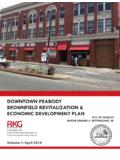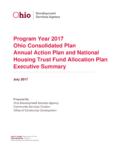Transcription of Community Involvement - SMARTe - SMARTe
1 2010 Community InvolvementOverviewMany revitalization projects are the beginning of an entire Community renewal. The long-term benefits of these projects can include the creation of more jobs, improvement in Community relations, Community empowerment, heightened economic status, environmental restoration and enhancement of the quality of life in the neighborhood through environmental assessment and/or cleanup. This section discusses what Community Involvement is, why it is important, and what its challenges are. Information on how to conduct a Community Assessment, and information on the importance of communication in actively informing and involving a Community is presented. Finally, this section includes information and links for techniques, guidance and tools for development of an effective Community Involvement program. Community Involvement is a very important aspect of revitalization for any Community , no matter what size.
2 Without Community buy-in, a project may never get off the ground or will not be accepted once it is completed. In the United States, Federal Brownfield grant monies are tied to Community Involvement ( , without implementing and documenting the Community Involvement initiative), no monies will be awarded. Often this requirement is a stumbling block for entities/communities seeking federal grant monies. Either Community Involvement is regarded as a minor nuisance and is ineffectively addressed, or there is a lack of knowledge as to how to engage the Community . Either way, the result can be disastrous ( , delays in construction can result in a loss of money, filing of law suits, disgruntled citizens providing negative comments to the media, non-acceptance of the revitalization project, and a non-sustainable project reverting back to a brownfields site the very thing that was supposed to be remedied).
3 Community Involvement should be used to generate not only ideas for revitalization projects and their implementation, but also ideas to further improve existing project features. revitalization can be facilitated and enhanced by finding out what the Community needs, what will benefit the Community , what has been tried in the past, and what could be done to improve past ideas. Community members, when given an opportunity to be informed and involved in the revitalization process, are or can be a critical factor to a project s success. Community members may have special issues or concerns that, if incorporated into a project at the outset, may help to reduce the likelihood of challenges to risk assessment results, and potential remediation or revitalization Community Involvement is based upon information and dialogue. Only an informed Community can be part of the decision- making process, which then will lead to a sustainable revitalization project.
4 Community members who contribute to the revitalization planning process will better understand the process and will be more likely to support a project they had input in. Community Involvement Challenges include: Performing a Community assessment in a town without a master plan or preference for redevelopment optionsPage 1 of 2010 Reaching consensus from diverse backgrounds and needs Accommodating interests when feasible and within the goals of the project Conducting Community Involvement or participation among the local residents, who have competing priorities/language barriers Building trust among various stakeholders Effectively conveying to local residents other stakeholders Involvement and support of the revitalization process Educating residents about the goals of the project/process Communicating technical information in an easy to understand manner Identifying stakeholders that can represent a diverse constituency, and represent these constituencies at public meetings and planning AssessmentCommunity assessment answers the basic questions: Who is the Community ?
5 Where do they live and work? Who will most directly be impacted by the revitalization project? What are the unique attributes of the Community ? What is the Community s vision for revitalization ? A Community assessment is a study that requires data and can: Define the Community by gaining useful information on the current economic status, crime and census reports, educational systems, and existing stigmas Identify stakeholders and local governmental leaders Establish realistic expectations for the Community input Identify Community goals and aspects for the future of the Community Educate residents on the process of project development Identify specific aspects of the project that can accommodate some of the Community goals Identify infrastructure and transportation issues Identify Community needs ( , open space, affordable housing, etc.) Start the communication process by fostering a dialogue, seeking Community interest and support, and sharing information, remediation, and redevelopment issues Determine if the reuse or demolition of the site will benefit the Community Develop revitalization plans that involves the Community , makes Community improvements and respects the Community s culture Establish a local commitment to the project, ensuring maintenance, local Involvement , and long-term improvements Contribute to a sustainable end product Page 2 of 2010A Community assessment is fundamental to the understanding of the Community s needs, problems, distressed populations, and how the proposed revitalization will ultimately affect the Community .
6 A site to be revitalized is nearly always a part of a much bigger picture. Community -specific information is critical to the overall success of a revitalization plan. Creating a Community assessment study is a process that requires knowledge of the Community s social and economic history, culture and collective character, current composition, Community assets, and the physical, biological and functional attributes of the natural ecosystem(s) in which its members interact (EPA 1998). As such, it is a tool that can be used to gather important local data, , key issues, needs, concerns. Another important aspect of a Community assessment is that it starts a dialogue with the Community as a whole, as well as, Community members who envision a future potential for a given Community . If a revitalization project is large and of regional importance, then the Community closest to the project should be considered as having more of a stake and interest in it than others located farther away.
7 For a smaller revitalization project, the Community directly affected by the project should be considered. A Community assessment helps in understanding a Community s priorities and vision, and a successful revitalization project will have responded to these priorities and information contained in a Community assessment is organized in the following categories:The History of the Community :Where are the historical files kept for the public s use and what is the history of the Community ? Have any site assessments or property studies been conducted in the past? When was the site or area operating with economic vitality and when did economic decline begin? What industries were previously present, and why are they no longer present? What are the statistics on the current jobs in the Community , current family status, income, zoning, public transportation, educational backgrounds, and information on the government officials?
8 What type of news seems to reflect a certain theme or cultural attributes of the Community ( , local holidays and celebrations; well known residents; resident/ Community meetings; and any event that involves a high level of local resident Involvement )? Are there environmental justice issues, meaning that no racial, ethnic, or socioeconomic group should bear a disproportionate share of negative environmental consequences? Has the Community been disproportionately impacted by environmental factors? Is the public engaged in other revitalization efforts and, if so, are there any lessons to be learned about their successes or failures? The Visual Themes in the Community : Is there a recurring architectural influence or original construction that may be lost if not preserved? Are there attractive Community features? Is there a certain expectation for the revitalization project that must be respected in order to receive support from local residents?
9 Are there historical and preservation areas (this is important even in towns that are nearly abandoned, since recreating a historical representation can often be a key component of revitalizing potentially contaminated sites)? How relevant is your revitalization idea to the Community (if your revitalization idea is relevant to the Community , the more accepted and supported the revitalization will be)? If an artist s conception or model of the envisioned project is shown to the Community , how can one engage the people of the Community to be more involved and provide feedback about the envisioned project? The Heart of the Community : Where is the heart of the town or city? What are the key Community interest areas? Where are the Page 3 of 2010meeting places, and the center of the Community celebrations and exhibitions (perhaps there is an area where local musicians gather to play music, or a shopping area that attracts local gatherings)?
10 If none of these areas or places exist, how can the property be redeveloped into a Community meeting place (this could be an alarming reason for the downsizing and economic decline of the city; this is an excellent way to gain Community support and make a lasting impression)? What are the roles of schools, churches, social and civic organizations and other institutions? Who lives and works in this Community ? What languages are spoken? What minority groups are present?The Economic Opportunities within the Community : What is the current income distribution, in the area surrounding the proposed site? What are the main occupations of the residents? Do historical records reflect a similar story to the current economy? How can this revitalization plan incorporate needed jobs and possible educational opportunities? What possibilities will invite business into the Community and draw Involvement from the local residents?






